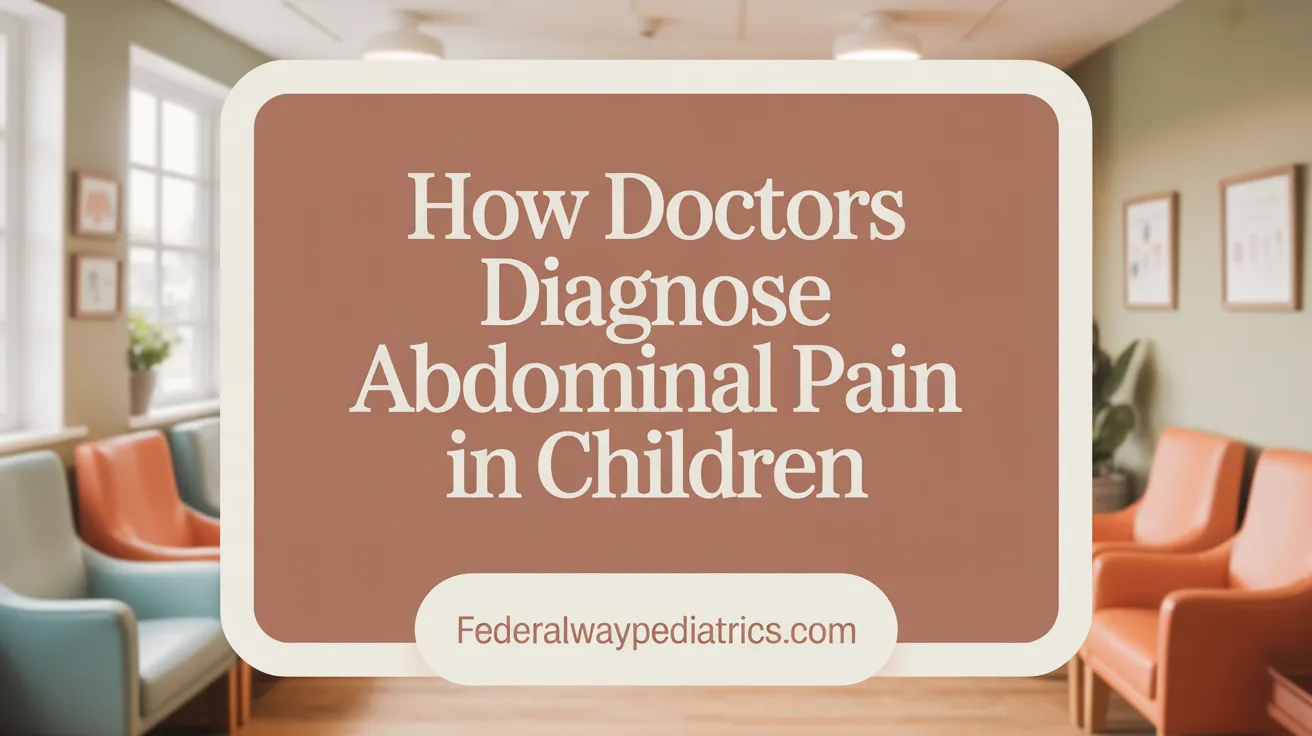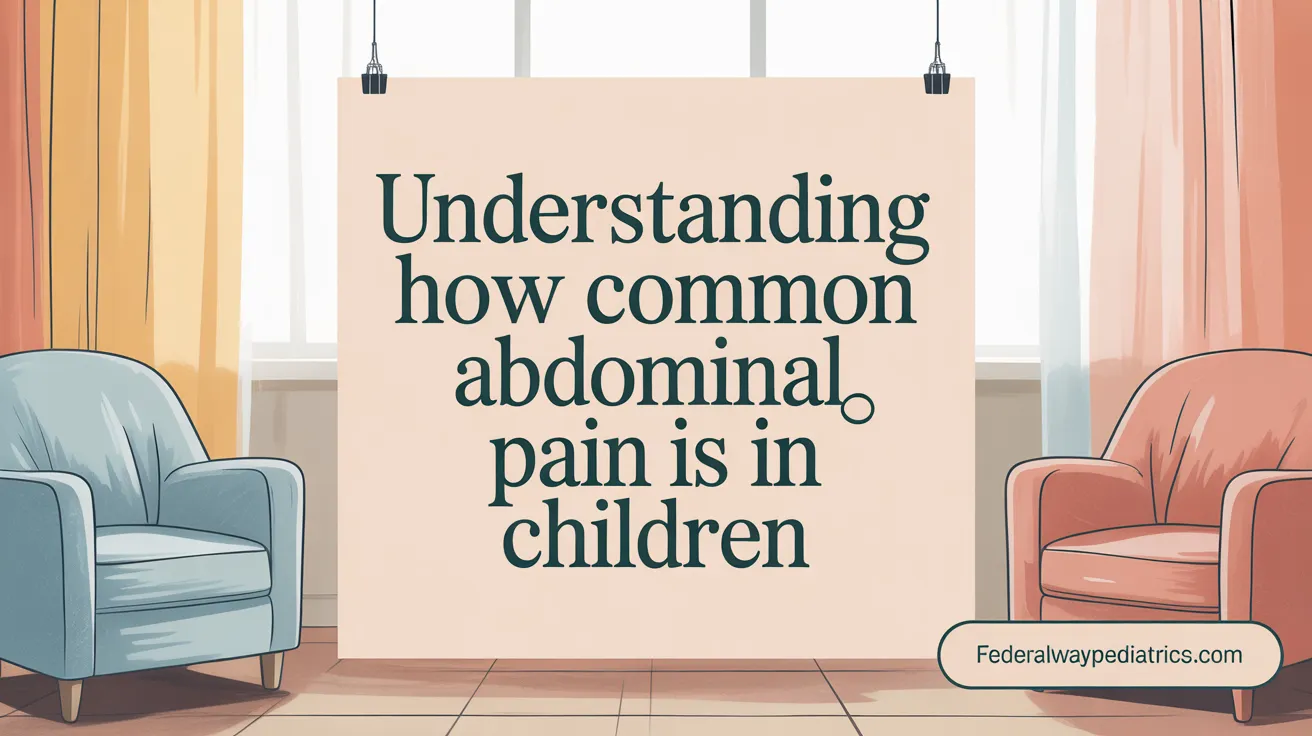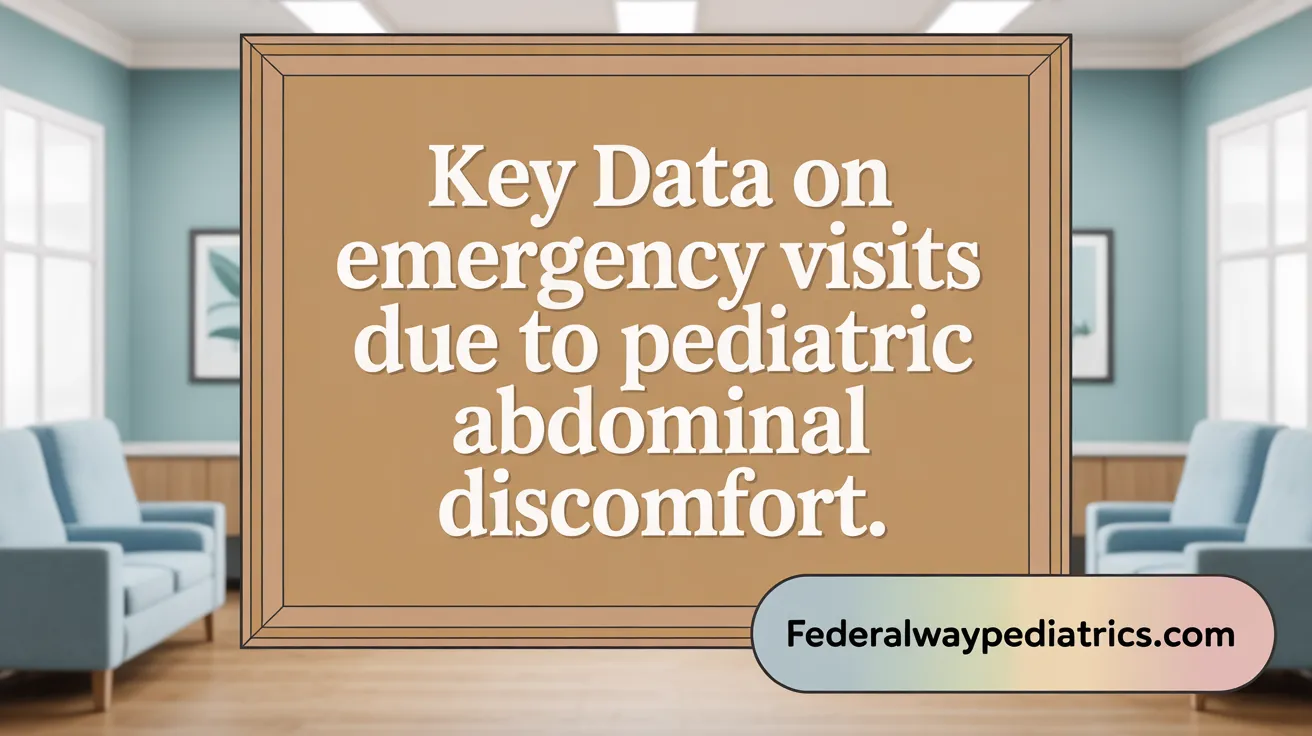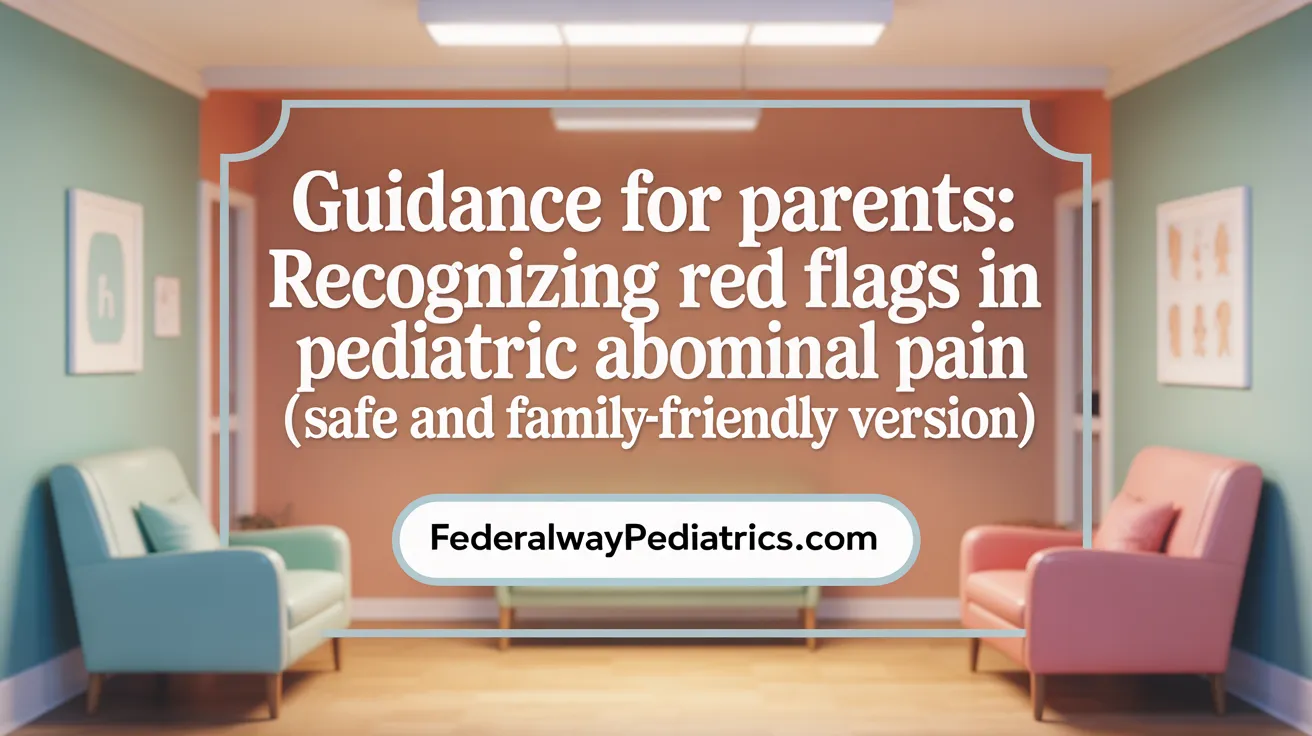Introduction to Pediatric Abdominal Pain
Abdominal pain is one of the most frequent complaints in children visiting healthcare providers, ranging from mild discomfort to severe emergencies. Understanding its causes, symptoms, diagnostic approaches, treatment options, and when to seek emergency care is vital for parents, caregivers, and healthcare professionals alike. This article explores the epidemiology, clinical features, and management strategies of abdominal pain in children, along with an examination of healthcare utilization patterns and demographic disparities affecting outcomes, particularly in emergency settings.
Common Causes of Abdominal Pain in Children
What are the common causes of abdominal pain in children?
Abdominal pain in children spans a wide spectrum, from benign issues that resolve on their own to urgent surgical emergencies. Most cases are caused by non-serious conditions like constipation, gastroenteritis, and other viral syndromes, which make up a significant portion of pediatric complaints. These conditions often present with symptoms such as nausea, vomiting, diarrhea, or bloating.
However, clinicians must also be vigilant for more severe causes that require immediate intervention. The most common surgical cause is appendicitis, which accounts for about 1% to 3% of pediatric abdominal pain cases and can rapidly progress to perforation if not diagnosed early. Other surgical emergencies include intussusception—most common in infants aged 4 to 10 months—malrotation with volvulus, and incarcerated inguinal hernias.
In adolescents, causes related to reproductive organs or pregnancy-related issues are important. For girls, ovarian torsion and ectopic pregnancy need prompt evaluation. Boys may present with testicular torsion, which causes sudden, severe pain and demands urgent surgical correction.
The evaluation of abdominal pain involves a detailed history and physical examination, supported by laboratory tests and imaging. Ultrasound is the preferred initial imaging modality due to its safety and effectiveness. Recognizing warning signs—such as persistent vomiting, blood in stool or vomit, a rigid abdomen, or signs of shock—is essential for identifying serious conditions.
Overall, while most causes are benign, early detection of surgical conditions is critical to prevent complications, including perforation, peritonitis, and increased morbidity.
Symptoms Associated with Abdominal Pain in Pediatric Patients
What symptoms are associated with abdominal pain in children?
Children experiencing abdominal pain may present with a range of symptoms that provide insights into the underlying cause. Commonly, they report localized or diffuse stomach pain, which can vary in intensity and character.
Nausea and vomiting frequently accompany abdominal discomfort, especially in conditions like gastroenteritis or appendicitis. Diarrhea or constipation may also occur, depending on the ailment, alongside systemic signs such as fever.
The pain's location can help narrow down potential causes. For example, pain around the belly button that migrates to the lower right abdomen often suggests appendicitis, while upper abdominal pain might be linked to indigestion or gastritis.
Children may wake up from sleep due to pain or experience it after eating, indicating possible gastrointestinal issues.
Other notable symptoms include blood in stool or vomit, which is a red flag for bleeding or serious conditions. Severe, persistent pain or difficulty breathing might signal critical problems requiring urgent care.
Signs of dehydration like dry mouth, lethargy, or decreased urination can be associated with vomiting or diarrhea. Pain that worsens with movement or physical activity is another concern.
Additional symptoms such as painful urination, weight loss, joint pain, or changes in bowel or bladder habits can suggest more severe or systemic illnesses.
Most episodes of abdominal pain in children are benign and resolve with supportive care such as hydration, rest, and dietary adjustments. However, warning signs—including severe pain, persistent vomiting, blood in stool or vomit, and difficulty breathing—necessitate prompt medical evaluation to rule out serious conditions.
Diagnostic Approaches in Pediatric Abdominal Pain

How is pediatric abdominal pain diagnosed?
The diagnosis of pediatric abdominal pain relies on a combination of detailed history-taking and physical examination. Clinicians assess when and how the pain started, its exact location, intensity, and any associated symptoms like vomiting, diarrhea, or fever. It's important to identify recent illnesses, injuries, or changes in behavior that could influence diagnosis.
Laboratory investigations play a supportive role in narrowing down causes. Routine tests include urinalysis, which helps detect urinary tract infections—a common cause in children, especially females. Complete blood count (CBC) provides information about infection or inflammation, while pregnancy tests are crucial in adolescents to rule out ectopic pregnancy. Inflammatory markers such as ESR or CRP can indicate systemic inflammatory processes.
Imaging is a cornerstone of diagnosis, with ultrasonography being the preferred initial modality of choice. Ultrasound offers detailed visualization of abdominal organs without ionizing radiation, making it ideal for evaluating appendicitis, ovarian cysts, intestinal obstructions, or malrotation. It also aids in identifying conditions like intussusception, which often presents with episodic pain.
When ultrasound results are inconclusive or further detail is required, additional imaging such as computed tomography (CT) scans may be necessary. However, clinicians weigh the benefits of detailed imaging against radiation exposure, especially in younger children.
Identifying signs of urgent surgical conditions—such as rebound tenderness, rigidity, absent bowel sounds, or systemic signs like fever—is critical. Recognizing these features prompts timely surgical intervention, avoiding complications like perforation or peritonitis. Overall, a systematic approach combining history, examination, laboratory tests, and imaging facilitates accurate diagnosis and guides effective management in children with abdominal pain.
Treatment and Management Strategies for Pediatric Abdominal Pain
What treatment options and management strategies are available for abdominal pain in children?
Treatment approaches for abdominal pain in children depend greatly on the specific cause. For benign causes such as gas, constipation, or minor infections, supportive care often suffices. This includes ensuring adequate hydration, encouraging rest, providing a bland diet, applying heat to the abdomen, and administering over-the-counter pain relievers like paracetamol. These measures are usually effective in managing mild discomfort.
However, if symptoms persist, worsen, or show signs of serious underlying issues—such as high fever, persistent vomiting, blood in stool or vomit, or intense pain—immediate medical assessment becomes crucial. Diagnostic procedures may involve blood tests, urinalysis, stool analysis, ultrasound imaging, and other investigations to rule out conditions like appendicitis, bowel obstruction, or inflammatory bowel disease.
Serious conditions generally require targeted treatments. Appendicitis often necessitates surgical removal of the appendix, while bowel obstructions might require surgery or endoscopic procedures. Infections, such as urinary tract infections or gastroenteritis, are managed with antibiotics or supportive therapy, respectively.
For children with recurrent or chronic abdominal pain, a multidisciplinary approach is most effective. This includes medical management of symptoms and addressing associated psychological or emotional factors, such as stress, anxiety, or depression. Behavioral therapies, dietary modifications, and sometimes psychological counseling help manage the symptoms and improve overall quality of life.
Overall, close follow-up and tailored interventions are essential, and parents should seek medical attention if symptoms are severe, persistent, or accompanied by red flags indicating more serious illness.
When to Seek Emergency Care for Abdominal Pain in Children
When should children with abdominal pain receive emergency care?
Children experiencing abdominal pain should seek emergency medical attention if they present with certain warning signs or symptoms that suggest a serious or urgent health issue. These signs include sudden, severe, or worsening pain that persists longer than an hour, especially if the pain is so intense that it causes the child to be unable to move or if it wakes them from sleep.
Additional critical indicators include high fever, ongoing vomiting — particularly green or bloody — bloody diarrhea, and signs of dehydration such as dry mouth, dizzy spells, or decreased urination. Abdominal distention or tenderness that cannot be explained should also prompt immediate evaluation. These symptoms can indicate conditions such as appendicitis, bowel obstruction, or other surgical emergencies.
Infants, particularly those under 12 weeks old, with persistent or severe abdominal symptoms need urgent medical care. Children with recent abdominal trauma, pre-existing health issues like congenital abnormalities, or those showing signs of shock, difficulty breathing, lethargy, or inconsolability must be evaluated promptly.
Serious concerns also arise if the child has signs of internal bleeding, seizures, fainting, or if their behavior suggests they are severely unwell. When in doubt, it’s safest to seek emergency care to ensure timely diagnosis and treatment. For parents and caregivers, recognizing these warning signs is crucial to prevent complications and ensure the child's safety.
If you notice any of these symptoms or if the child's condition appears to be worsening, do not delay in taking them to the nearest emergency department. Early intervention can significantly reduce the risk of severe outcomes such as perforation, sepsis, or death.
Summary table of warning signs
| Warning Signs | Description | Potential Condition |
|---|---|---|
| Sudden, severe, or worsening pain | Intense pain that begins abruptly or escalates quickly | Appendicitis, bowel obstruction |
| Persistent pain over 1 hour | Pain lasting longer than one hour without relief | Serious abdominal pathology |
| High fever | Fever above 102°F in conjunction with pain | Infection or inflammation |
| Vomiting (green or bloody) | Persistent vomiting with unusual appearance | Intestinal blockage or bleeding |
| Bloody stool or vomit | Blood in stool or vomit | Gastrointestinal bleeding |
| Signs of dehydration | Dry mouth, dizziness, decreased urination | Severe illness or infection |
| Abdominal distention or tenderness | Swelling or pain on touch | Obstruction, perforation |
| Recent trauma or pre-existing conditions | Any injury or known health issue affecting abdomen | Trauma, congenital anomalies |
Knowing when to seek emergency care can make a significant difference in outcomes for children with abdominal pain. Caregivers should be vigilant and act swiftly when these warning signs appear.
Epidemiology and Prevalence of Pediatric Abdominal Pain
 Pediatric abdominal pain is a common concern in childhood healthcare, with significant variation across different regions and age groups. Globally, the prevalence of functional abdominal pain disorders is estimated at around 13.5%, making it one of the most frequent reasons children seek medical attention for stomach issues.
Pediatric abdominal pain is a common concern in childhood healthcare, with significant variation across different regions and age groups. Globally, the prevalence of functional abdominal pain disorders is estimated at around 13.5%, making it one of the most frequent reasons children seek medical attention for stomach issues.
Among these disorders, irritable bowel syndrome (IBS) stands out as the most common diagnosis, affecting approximately 8.8% of children worldwide. The rates of functional abdominal pain tend to be higher in South America (around 16.8%) and Asia (about 16.5%) compared to Europe (roughly 10.5%). This variation may reflect cultural, dietary, or healthcare access differences.
Gender differences are notable, with girls more frequently experiencing functional abdominal pain (about 15.9%) than boys (approximately 11.5%). These conditions are often linked to psychological factors such as anxiety and depression, highlighting the complex interplay between mental health and gastrointestinal symptoms.
In terms of healthcare utilization, acute abdominal pain accounts for approximately 9% of primary care visits in children. While most cases are benign and resolve with home care, a small percentage—around 1%—require surgical intervention, mainly for conditions like appendicitis.
The majority of cases are functional, with no identifiable physical cause. Organic illnesses, including inflammatory bowel disease or infections, are less common but essential to recognize for appropriate treatment. Overall, understanding these prevalence patterns helps guide clinicians in distinguishing between benign and serious causes of abdominal pain in children.
| Aspect | Data | Additional Details |
|---|---|---|
| Global prevalence of functional abdominal pain | ~13.5% | Higher in South America and Asia |
| Most common specific disorder | Irritable bowel syndrome | ~8.8% globally |
| Gender differences | Girls (15.9%) vs Boys (11.5%) | Noted for higher incidence in females |
| Common diagnoses in healthcare visits | Abdominal pain, gastroenteritis, respiratory infections | Most cases benign, self-limited |
| Percentage requiring surgery | About 1% | Mainly for appendicitis |
| Age-related trends | Peak in school-age children | Chronic pain defined as lasting > 2 weeks |
Staying aware of these statistical insights assists healthcare providers in early diagnosis, management, and addressing the psychological aspect associated with pediatric abdominal pain.
Healthcare Utilization and Emergency Department Visits for Pediatric Abdominal Pain

What data exists regarding healthcare utilization for children with abdominal pain, including emergency department visits?
There is extensive data showing that abdominal pain is a common reason for children to seek emergency care. In the United States, over 9.6 million visits annually are attributed to pediatric abdominal pain. These visits account for a significant proportion of emergency department (ED) utilization, with abdominal pain ranked as a leading cause of pediatric ED visits.
Most cases are non-surgical, with about 84% of these children diagnosed with benign causes like gastroenteritis or functional abdominal pain. Surgical causes—primarily appendicitis—occur in approximately 1% to 3% of cases, highlighting that most children are managed conservatively.
Research analyzing data from multiple EDs has revealed disparities in presentation and outcomes. For instance, minority and low-income children tend to experience higher rates of complication, such as perforated appendicitis, and face barriers to diagnostic imaging like CT scans. These disparities contribute to delayed diagnoses and greater health risks.
A detailed retrospective study involving over 120,000 pediatric ED visits across 26 hospitals emphasized variability in imaging practices and highlighted that delays in diagnosing conditions such as appendicitis are linked with poorer outcomes.
Broader healthcare utilization data indicate that pain-related visits—encompassing various causes including abdominal pain—represent a significant portion of pediatric emergency care. Factors influencing visit frequency include age, socioeconomic status, and race, with children from lower socioeconomic backgrounds and minority groups often experiencing longer wait times and worse health outcomes.
This body of data underscores the importance of prompt, equitable assessment and management of abdominal pain in children to prevent complications and optimize healthcare resource use.
Disparities and Demographic Factors in Pediatric Abdominal Pain and Emergency Care
Are there disparities or demographic factors associated with pediatric abdominal pain and emergency visits?
Research indicates that there are notable disparities in the diagnosis, treatment, and outcomes of children presenting with abdominal pain in emergency settings. Racial and socioeconomic factors play significant roles in determining the quality and timeliness of care.
Minority children, particularly those who are Black or Hispanic, often experience higher rates of complications such as perforated appendicitis. Despite similar symptoms and clinical presentations, these groups are less likely to receive prompt diagnostic imaging like CT scans or ultrasounds. In contrast, White children tend to have quicker diagnoses and more immediate assessments, which can lead to better outcomes.
Socioeconomic status also influences care delivery. Children from low-income families or those enrolled in Medicaid or CHIP are less likely to undergo advanced imaging or receive opioid analgesics for pain relief compared to their higher-income counterparts. This discrepancy can delay treatment, increase the risk of complications, and prolong hospital stays.
Language barriers and caregiver-related factors further impact the management of pediatric abdominal pain. Non-English speaking caregivers may face communication challenges that hinder comprehensive history-taking, which is crucial for diagnosis.
Studies reveal that these disparities are not solely due to differences in disease severity; they often stem from systemic issues within healthcare delivery, including resource availability, implicit biases, and healthcare policy limitations.
In terms of outcomes, minority children are more prone to developing severe conditions like perforated appendicitis, requiring more extensive surgical intervention and longer recovery periods. These findings emphasize the importance of equitable access to diagnostic tools and timely care for all pediatric populations.
| Demographic Factor | Impact on Care | Associated Outcomes |
|---|---|---|
| Race (Black, Hispanic) | Less likely to receive imaging, analgesia | Higher risk of perforation, delayed diagnosis |
| Socioeconomic status | Reduced access to diagnostics and pain management | Longer hospital stays, increased complications |
| Language barriers | Communication challenges affecting history-taking | Potential for misdiagnosis or delayed treatment |
Overall, addressing these disparities requires targeted efforts to ensure equitable healthcare access, improve communication strategies, and mitigate biases in pediatric emergency care.
Pathophysiology and Characteristics of Functional Abdominal Pain in Children
What is functional abdominal pain and how common is it?
Functional abdominal pain is a widespread condition in children that causes recurring belly discomfort without an identifiable physical cause. It is considered the most common reason for chronic stomach pain in young patients, affecting between 0.3% and 19% of school-aged children in the US and Europe. In most cases, additional medical testing cannot find a specific disease, and about 90% of children with this diagnosis show no underlying medical disorder.
How does the gut-brain axis influence abdominal pain?
The nervous system plays a significant role in functional abdominal pain. An overly responsive gut-brain axis, often influenced by early life events such as infections or surgeries, results in hypersensitive nerve signaling from the gastrointestinal tract to the brain. This heightened sensitivity can produce pain signals even when the GI tract is normal, creating a syndrome similar to a hypersensitive stereo receiver.
What triggers this type of pain?
Stress and emotional factors are common triggers that exacerbate symptoms. Food intolerances, psychological stressors, and recent infections can all contribute to increased gut sensitivity. Dietary factors, such as food allergies or intolerances, also influence symptom severity but are less definitive causes.
What are the typical clinical features?
Children usually present with pain that they find hard to describe, often scaled around the belly button, and not associated with meals or activity. The pain tends to be episodic, lasting less than an hour, and does not interfere significantly with daily activities.
Most children continue to eat and gain weight normally, sleep well, and attend school despite their pain. However, red flags like weight loss, persistent vomiting, or blood in stool should prompt evaluation for other underlying conditions.
How does this condition affect children?
Though distressing, functional abdominal pain generally does not impair a child's growth or development. Management focuses on coping strategies such as relaxation techniques, mindfulness, dietary adjustments, and psychological support when needed. Recognizing that stress and emotional health play a pivotal role can help guide effective treatments.
This comprehensive understanding of functional abdominal pain highlights its complex origins involving the nervous system and psychosocial factors, emphasizing the importance of a holistic approach to its management.
Chronic Abdominal Pain and Its Relation to Mental Health in Pediatric Patients
What are the prevalence and common chronic causes?
Chronic abdominal pain affects a notable percentage of school-aged children, with estimates ranging from 0.3% to 19%. Most cases—around 90%—are classified as functional abdominal pain, where no specific medical disease is identified.
Common causes of long-lasting abdominal discomfort include conditions like irritable bowel syndrome (IBS), abdominal migraine, and other functional gastrointestinal disorders. In many children, symptoms such as pain that wakes them up, abnormal bowel movements, bloating, and blood in stool point toward specific underlying issues like constipation, inflammatory bowel diseases such as Crohn’s disease, or food intolerances.
How is it linked to depression, anxiety, and bullying?
Research shows a strong association between persistent abdominal pain and mental health problems such as depression and anxiety. Children dealing with ongoing pain often report poorer overall health, emotional distress, and are more prone to experiences like bullying.
These emotional factors can both exacerbate the perception of pain and complicate management, creating a cycle of distress that impacts their daily lives, school attendance, and social interactions.
What are the long-term health outcomes and effects on quality of life?
Children with chronic abdominal pain, especially if compounded by psychological issues, tend to experience recurrent episodes that can interfere with typical development and social functioning. Such persistent pain and associated emotional challenges increase the risk of ongoing mental health issues into adolescence and even adulthood.
Quality of life may be significantly reduced, with children feeling isolated, anxious, or depressed, which can further hinder their recovery and overall wellbeing.
Why is multidisciplinary management important?
Effective treatment requires a comprehensive approach that addresses both physical and psychological aspects. This includes medical assessments, behavioral therapy, dietary modifications, and sometimes psychological support to help children develop coping strategies.
Parents are encouraged to keep detailed food and symptom diaries, recognize stress triggers, and foster supportive environments. Collaboration among pediatricians, mental health professionals, dietitians, and school counselors can significantly improve outcomes.
| Aspect | Focus | Additional Details |
|---|---|---|
| Prevalence | 0.3-19% of school-aged children | Most cases are functional; no detectable disease |
| Common causes | IBS, abdominal migraine, food intolerance, constipation | Symptoms include waking pain, bowel changes, bloating |
| Mental health link | Depression, anxiety, bullying | Emotional distress worsens pain perception |
| Long-term effects | Recurring pain, mental health issues | Reduced quality of life, social impact |
| Management | Multidisciplinary | Medical, psychological, lifestyle interventions |
Educational Guidance for Parents and Caregivers on Pediatric Abdominal Pain

Recognizing warning signs and red flags
It is essential for parents and caregivers to be familiar with certain warning signs that may indicate a serious underlying problem in children experiencing abdominal pain. While most cases are benign or functional, red flags include pain lasting longer than two weeks, unexplained weight loss, persistent vomiting, blood in stool or vomit, and severe symptoms like high fever or inability to pass stool. These signs suggest the need for prompt medical evaluation to rule out conditions such as appendicitis, intestinal obstruction, or other serious illnesses.
Management of benign and functional pain at home
Most stomachaches in children are harmless and resolve with simple home care. Parents can help by encouraging rest, providing fluids, and offering bland foods that are gentle on the stomach. Over-the-counter pain relievers like paracetamol can be used safely to alleviate discomfort. For functional abdominal pain, relaxation techniques like deep breathing, mindfulness, and distraction can be beneficial. Maintaining routines, managing stress, and keeping a simple food diary are strategies that can help children cope better.
When to seek medical advice
Despite the benign nature of most pediatric abdominal pain, parents should seek medical attention if symptoms persist beyond a few days, worsen, or are accompanied by warning signs such as blood in stool, vomiting, significant weight loss, or severe tenderness. Children who are unable to eat or drink, exhibit high fever, or show signs of dehydration require urgent assessment. Healthcare providers can conduct necessary exams and tests to identify or exclude more serious conditions like appendicitis, infections, or surgical emergencies.
Communication strategies with children experiencing pain
Effective communication is vital in helping children express their discomfort and understand their condition. Use age-appropriate language to validate their feelings and reassure them that their symptoms are being taken seriously. Encourage children to describe their pain's location, intensity, and nature to help guide diagnosis. Techniques such as distraction, relaxation, and maintaining a calm environment can help reduce anxiety and perceived pain. Supportive listening and explaining medical procedures in simple words foster a trusting relationship and reduce fear during medical visits.
Understanding when and how to respond to pediatric abdominal pain empowers parents and caregivers to provide appropriate care, reduce unnecessary anxiety, and ensure timely medical intervention when needed. Recognizing symptoms, managing minor issues at home, and maintaining open, reassuring communication can make a significant difference in a child's comfort and health outcomes.
Clinical Red Flags and Abdominal Swelling in Pediatric Patients

What are the primary causes of abdominal swelling related to abdominal pain?
In children, abdominal swelling associated with pain can be explained through the "six F's": fluid, fat, faeces, flatus, fetus, and fatal masses.
- Fluid: Ascites resulting from liver or kidney issues, or bleeding within the abdomen, can cause distension. Signs include dullness to percussion and a sense of fluid wave.
- Fat: Obesity or increased adipose tissue can lead to generalized abdominal enlargement, which may or may not be painful.
- Faeces: Severe constipation or bowel obstruction can cause distension and discomfort, often presenting with bloating and palpable bowel loops.
- Flatus: Gas buildup from indigestion or bowel obstruction leads to gaseous distension, often with hyper-resonance on percussion.
- Fetus: In adolescent females, pregnancy—including ectopic pregnancy—is a critical cause of abdominal swelling with associated pain.
- Fatal masses: Large tumors or hepatosplenomegaly from conditions like lymphoma or organomegaly from other causes can present with significant swelling and discomfort.
Underlying conditions such as liver diseases, bowel obstructions, or pregnancy may contribute to these presentations.
Signs of potentially serious pathology
Certain symptoms accompanying abdominal swelling warrant urgent evaluation. These red flags include persistent or worsening pain, inability to pass stool or gas, signs of shock, blood in stool or vomit, and palpable masses with irregular or hard features.
In neonatal and early childhood settings, signs like bilious vomiting, abdominal rigidity, rebound tenderness, and voluntary guarding suggest urgent surgical causes such as volvulus or perforation.
In adolescents, sudden sharp pain with swelling could indicate torsion of reproductive organs or other emergent conditions.
Role of physical examination and imaging in evaluation
Physical examination is crucial to differentiate benign causes from serious emergencies. To assess swelling, clinicians check for tenderness, masses, bowel sounds, and signs of peritonitis.
Imaging modalities, especially ultrasound, are first-line tools because they are non-invasive and effective in detecting fluid collections, organomegaly, masses, or obstruction. Further imaging, like CT or MRI, may be necessary for detailed assessment.
Procedures such as fluid aspiration can provide diagnostic insights and relief when fluid accumulates.
Importance of early recognition for prompt treatment
Early diagnosis of causes of abdominal swelling and pain is vital to prevent serious complications like bowel ischemia, perforation, or organ failure.
Prompt recognition of signs indicating urgent pathology allows for timely surgical intervention or other treatments, significantly improving outcomes.
Disparities exist in the evaluation and treatment based on race and socioeconomic status, underscoring the need for equitable access to diagnostics such as imaging and specialist care.
Ultimately, comprehensive assessment combining history, physical exam, laboratory tests, and imaging supports accurate diagnosis and effective management, reducing the risk of adverse health outcomes.
Concluding Insights on Abdominal Pain in Children
Abdominal pain in children is a complex and frequent clinical problem with a wide spectrum of causes ranging from benign functional disorders to life-threatening surgical emergencies. Early recognition of symptom patterns, judicious use of diagnostic tools, and prompt management are essential to optimizing outcomes. Awareness of healthcare disparities and efforts to address them are critical to ensuring equitable care for all pediatric patients. Educating parents and caregivers on when to seek care and how to support children experiencing abdominal pain can empower families and improve the overall quality of pediatric healthcare delivery. Continued research and quality improvement initiatives remain important to advance the understanding and management of pediatric abdominal pain in healthcare settings worldwide.
References
- Acute Abdominal Pain in Children - AAFP
- Clinical outcomes of children with acute abdominal pain - PubMed
- Abdominal Pain in Children | Boston Children's Hospital
- Health Outcomes in US Children with Abdominal Pain at Major ...
- Pediatric Chronic Abdominal Pain | Doernbecher Children's Hospital
- Psychosocial dimensions of pain disparities in youth diagnosed with ...
- Chronic Abdominal Pain - UCSF Benioff Children's Hospitals
- Epidemiology of paediatric pain-related visits to ... - BMJ Open
- Race and Acute Abdominal Pain in a Pediatric Emergency Department
